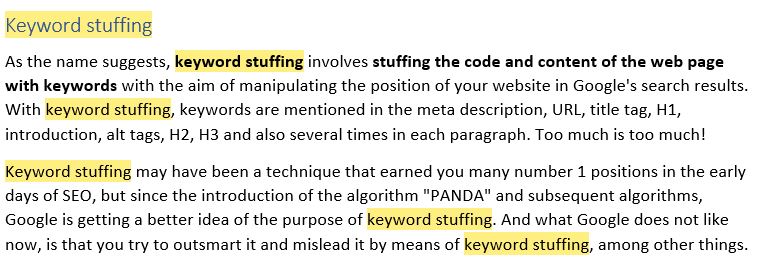The White Hat solution
Do you want to optimize your web pages correctly? Choose a topic that is relevant for you and your target audience and select relevant keywords accordingly. Then use these keywords only in the most important parts of the web page. These include for instance: the URL, title tag, and content. We also recommend using synonyms and variations of the focus keyword. This helps Google to better understand the subject and the whole context of the page. But remember: always write with your audience in mind! After all, you are writing for them.
3. Only focusing on popular, rather than relevant keywords
This is not exactly Black Hat SEO, but this practice goes hand in hand with “keyword stuffing”. We discussed above that it is not a good idea to stuff the webpage with a focus keyword and that it is important to use synonyms and variations as well. You need to make sure the content is super-rich.
Since the introduction of Hummingbird, BERT, and now recently the MUM (Multitask Unified Model) algorithm, Google understands content better and needs many other words. So you should not focus and build your content around one popular keyword, but also use other relevant and related keywords.
It is also much more difficult to achieve a high ranking for the very popular and therefore competitive keywords. We, therefore, recommend that you do not fixate on the keyword you have to use, but on the intention of your website visitors and their position in the customer journey. Long(er) tail keywords, which are much less competitive, are very interesting for reaching users who are in the later and decisive phases of the customer journey. Consequently, you will attract high-quality organic traffic to your website and increase the chance of conversions.
4. Over-optimization of Google My Business (GMB)

Optimized Google My Business listings are essential in your Local SEO strategy. They contain among others, your opening hours and business information and are given a prominent place in the organic search results.
In general, the more optimized your website is, the more it will be considered relevant by Google. Consequently, your Google My Business listings will benefit from your website’s performance and authority. And so you should also further optimize these listings. You can add a lot of information about your company and make sure that (new) customers can find you. But an over-optimization is never far away.
What is it about?
Google is against the over-optimization of Google My Business listings and considers it Black Hat SEO. It is more specific about certain elements, such as the name of your shop. Adding the most important keyword or the name of the town or village where the shop is located, can be considered as over-optimization. Do you have several shops in different cities? Then Google seems to tolerate adding the location in the name. Still, it is important to be careful.
Furthermore, you should also pay attention to the optimization of the company description and your answers to FAQs and reviews. Adding and repeating for example keywords, links, phone number, and email address is a striking indication for Google that you are trying to influence your visibility in the search results. What happens if Google notices this? It may reject your listing and not show it in the map pack.
How should you optimize it?
Now that you know what not to add to avoid Black Hat SEO, it is of course important to know what you should add/optimize. Below, we list some best practices for your Google My Business listings.
- The shop name should be short, clear, and correspond to your activity.
- Your answers to FAQs and reviews may contain keywords, but the answer must be natural.
- The description must be truthful, not exceed 750 characters and may contain generic keywords (but remember not to misuse them or repeat them too often).
- Other information, such as the address, telephone number, opening hours, website URL, qualitative pictures, and specific services and equipment of your business should be included in the spaces provided.
5. Low-quality content
In the SEO world, everyone agrees on one thing: Content is still king! In addition, longer content is preferred today. To rank as high as possible in the search results, it is important that you can offer a lot of relevant content on a certain subject. It is also crucial that this content is of good quality. A long article, but of poor quality, which actually contains a lot of nonsense, will not give you high rankings.
However, there are many (dodgy) online marketing agencies that recommend all kinds of techniques that can quickly give you a lot of content, but of low quality. If Google notices that the content is of low quality, it can potentially drastically reduce your website’s visibility in the search results. Some popular, but questionable content Black Hat SEO practices are:
Scraping
Simply put, it is about copying content from a more reputable website (perhaps your competitor’s) and using it for your own website. The content is thus literally “scraped” from a certain website. This can of course be a copyright infringement and lead to the next technique: duplicate content.
Duplicate content
This refers to two or more web pages, on one or more websites, that contain identical or almost identical content. So suppose you were to scrape a whole web page from another website and place it on one of your web pages, then there would be duplicate content and that is bad news for SEO.
Why? Google is doing its best to index and display pages with different content. When the search engine realizes that you are displaying duplicate content to influence and manipulate your rankings, and are therefore guilty of Black Hat SEO, it may review the indexing and ranking of your website. So be warned!
However, there are those who try to circumvent the penalties for duplicate content. A well-known trick is to use synonyms. The text will then not be completely identical and so the chance that Google will consider it as duplicate content is smaller, but of course not non-existent. So you are taking a big risk. Moreover, Google understands the semantic context of a text better and better, the relationship between words and therefore also synonyms.
Automated or automatically generated content
A hot and trendy topic within SEO is content automation. More and more companies are offering automation tools to quickly produce a lot of optimized content. This way, you can save time and spend it on other important things, like reading this article!
But beware, you should not leave the content creation for the full 100% to such tools. The result is often not of perfect quality. Once the content has been created, it is therefore important that you check it and, if necessary, adapt and optimize it yourself. If you do not, you risk that the content will be of low quality.
Conclusion: long content has become very important, but qualitative content is even more important.
6. Not monitoring your SEO-evolution

Of course, unlike the previous techniques, this is not a Black Hat SEO practice that Google penalizes, but still, not monitoring your progress (and decline) can be detrimental to the future of your website.
After all, Google is constantly making changes to the way they rank websites in the SERP. To stay on top, it is therefore important to continuously monitor and optimize your website.
A tool that can help you with this, and that we use for all our clients, is Google Search Console. With this tool, you can take a close look at your SEO performance (positions, clicks, and impressions), the status of a webpage (e.g. whether it is indexed or not), and the health of your website (e.g. crawl errors, broken links). Have you noticed, for example, that certain keyword positions are dropping or clicks are decreasing? Then it is time to take action. This tool offers you a lot of useful information and enables you to anticipate changes.
7. Cloaking
This is a Black Hat SEO technique where website visitors get to see different content on a page than search engine bots, again with the aim of ranking higher for certain keywords. It comes down to adding certain content that is not visible to users like you and me, but is visible to robots.
Types of cloaking
I can already hear you thinking: but how? Well, there are several ways you can do that. Some common ways are:
- Adding text in the same color as the page background.
- Hide text behind images.
- Showing robots different content than visitors.
- Manipulating JavaScript and CSS: for example, displaying text all the way to the left or right and outside the screen.
Some nuance
The last way in the list is often harder for Google to detect as cloaking, and therefore also harder to penalize. But Google’s algorithms are getting better and better, and so it is also becoming easier for the search engine to detect this Black Hat SEO technique.
Google recommends that all content on a page should be visible, but for UX reasons this is not always possible. A dynamic website, for example, has to hide some content because the website would otherwise not be attractive and user-friendly. This means that there is some flexibility in hiding content.
Go for White Hat SEO with Universem
Now you know which Black Hat SEO practices will completely destroy your position in search engines and already a bit which White Hat techniques we recommend. Would you like to really get started with search engine optimization for your business? Contact us and we will be happy to help!





